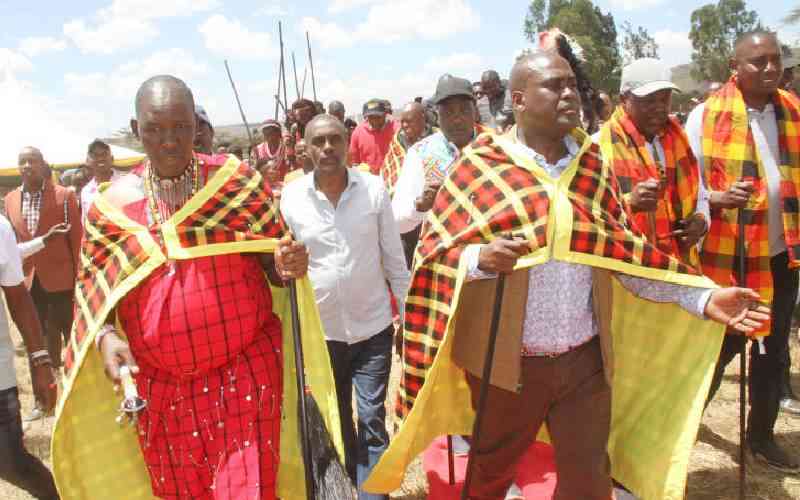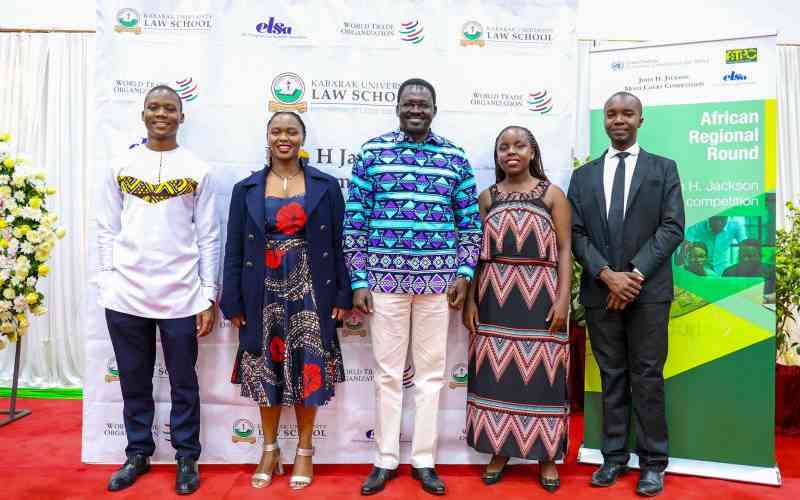By MAUREEN ABWAO and BRIGID CHEMWENO
Remote is an apt description of Kimana Shopping Centre in Kajiado South County. But its residents are forward-looking and open-minded than one would expect of a rural village in Maasailand.
The road to Kimana winds through semi-arid stretches and savanna, where wild animals roam freely. As we brave the rough journey past Amboseli National Park, the snow on top of Mount Kilimanjaro, the tallest in Africa, and which straddles Kenya and Tanzania, glimmers from a distance.
The shopping centre turns out to be a cluster of shops that most city dwellers would dismiss as a rural backwater. From here, five hours after we left the city, we need a guide to take us to our final destination; the Amboseli manyatta.
In such a far-flung area, one would expect to find die-hard traditionalists and a thriving administering of a culture long forgotten in many places. But the developments occurring here are making history.
We have been invited to a coming of age ceremony. There is no Female Genital Cutting (FGC) or spearing of wild animals though.
This is a major break from traditional Maa culture, where teenage, and sometimes younger, girls are circumcised and married off immediately. Their brothers are required to not only undergo ‘the cut’, but also bring home a game trophy, ideally a lion, to be considered real men.
The ceremony we are about to witness is a very important one because it includes iltuati, the installation of the chief moran, or warrior, of the Maasai community. This is a rare cultural event that usually takes place once every 20 years or so. Members of the local community have turned up in their hundreds. It is also a tourist attraction, and outsiders are well represented, cameras at the ready.
When it is time to start, the chants of the warriors echo in the air as they sing and dance to traditional songs that mark such important ceremonies, including Miboni, Etikisa and Nateyia, accompanied by the kudu, a traditional horn used to summon meetings. The expectant crowd comes to life; humming and clapping along, or clicking away as they capture moments from the extraordinary event to take home.
NEW GROUND
At the same function are young Maasai girls decked out in colourful beaded ornaments, with orange shukas wrapped around their shoulders. The look is crowned with a special headpiece, made just for this occasion; it says ‘No FGC’.
Not so long ago, it would have been taboo to even broach this topic in public, leave alone oppose a rite of passage that dates back centuries. But for these girls, puberty will not be welcomed by a cut that endangers their lives, being married off (sometimes to virtual strangers), or high-risk childbirth. They are free to mature, pursue their education, and choose their own husbands.
The girls are also treading on new ground in another way. Previously, this ceremony, and any other related to the warriors, was out of bounds for uncircumcised girls. In fact, they would not have been allowed near the emanyatta (moran camp), even without their anti-FGC regalia.
“This is quite a unique spectacle in the Maasai community as previously, anti-FGC campaigns would not be conducted at such an event,” says Nice Nailantei Lengete, Amref’s project officer for the Alternative Rites of Passage. “It was strictly a cultural affair and no modernity was allowed.”
But this exclusivity ended after the ceremony, when the young morans were allowed to engage in sexual activities with multiple partners, putting them and the girls at risk of contracting HIV.
Stay informed. Subscribe to our newsletter
Things are different now though. An interaction with Amboseli’s modern morans shows that most of these young men are in school and have joined the fight against HIV and female circumcision.
Hundreds of girls, such as a Susan Siyiampei, a Form Two student at Lenkisem High School, are undergoing an alternative rite of passage, where no blood is shed. The girls are educated on sexuality, hygiene, adult responsibilities, HIV and their rights.
“In the Maasai community, FGC is an old-age tradition that has been hard to fight. Previously, an uncircumcised woman from my community would not find a suitor. Even after the outlawing of the vice, it continues in secret in some areas,” explains Siyiampei.
Siyiampei considers herself lucky to be among the girls who have a choice on the course their future takes. It is a freedom their mothers and grandmothers could not have imagined.
“I now do not have to worry about circumcision; all I am required to do is to continue working hard in school so as to have a bright future. The elders have blessed us and accepted us as adults in the community,” says a delighted Siyiampei.
Through the alternative rites of passage, the young girls not only escape the pain of the knife, but also the risk of contracting HIV through sharing a blade, and life-threatening complications such as bleeding to death.
“Young girls are often traumatised after undergoing FGC, but many tend to remain silent because it is a cultural taboo for one to speak about sexual issues in the community,” explains Severina Lemachokoti, a teacher who is also a counsellor.
Through the alternative rite of passage known as Entito En Ma in the Maa language, the girls are taught to be more assertive as they are also encouraged to speak about their bodies and sexuality. The facilitators also speak to the young morans on safe sex, behaviour change and HIV and Aids.
Even the elders have joined the campaign to end unnecessary bloodshed and help Maa girls make more of their lives.
“We are doing away with practices that are of no value to us. Our daughters and granddaughters want formal education, and we, the elders, now know the value of sending them to school,” says William Orumoi, a community elder.
The slaying of wild animals has also been relegated to history. The future belongs to morans who prove their mettle in a different way.
“We now protect wild animals. We also encourage our young men to go to school, and as you have witnessed, the young man who was crowned the chief morans is a Form Three student; education is key,” Orumoi adds.
At the peak of the celebrations, the morans and girls are blessed by 60 elders, who symbolically sprinkle milk and liquor on them.
The ceremony ends in the afternoon as the morans, striking in their red regalia, hair painted with a mixture of red-oxide and oil melted from a bull’s fat, and bodies smeared with red ochre, showcase their prowess in the traditional Maasai jump known as adumu.
The men gather in small groups as they engage in the meat eating ceremony known as enkangoo-nkiri and drink the traditional brew under the shades of acacia trees, while women share their meals with the children.
The initiates are awarded certificates.
So far, more than 270 girls have escaped the cut in this area this year, and other alternative rite ceremonies will be conducted in August and December. The three-day programme was started in 2008 and has so far benefitted more than 2,000 girls.
 The Standard Group Plc is a
multi-media organization with investments in media platforms spanning newspaper
print operations, television, radio broadcasting, digital and online services. The
Standard Group is recognized as a leading multi-media house in Kenya with a key
influence in matters of national and international interest.
The Standard Group Plc is a
multi-media organization with investments in media platforms spanning newspaper
print operations, television, radio broadcasting, digital and online services. The
Standard Group is recognized as a leading multi-media house in Kenya with a key
influence in matters of national and international interest.
 The Standard Group Plc is a
multi-media organization with investments in media platforms spanning newspaper
print operations, television, radio broadcasting, digital and online services. The
Standard Group is recognized as a leading multi-media house in Kenya with a key
influence in matters of national and international interest.
The Standard Group Plc is a
multi-media organization with investments in media platforms spanning newspaper
print operations, television, radio broadcasting, digital and online services. The
Standard Group is recognized as a leading multi-media house in Kenya with a key
influence in matters of national and international interest.








